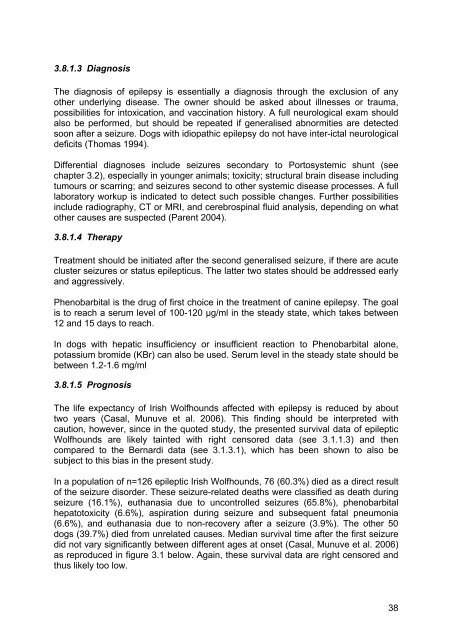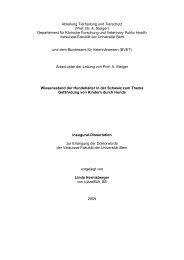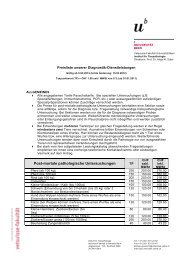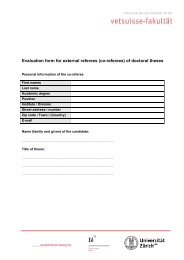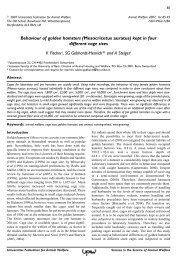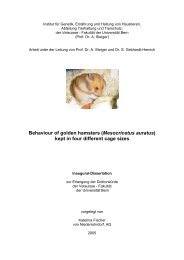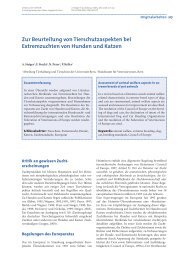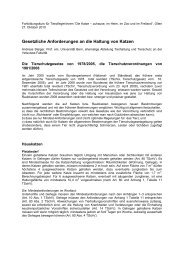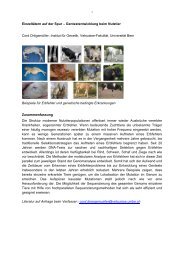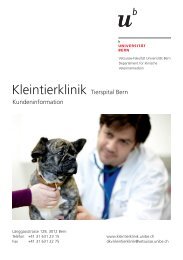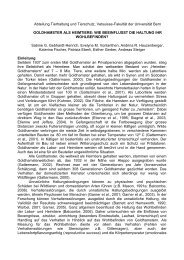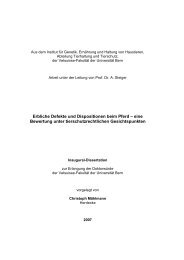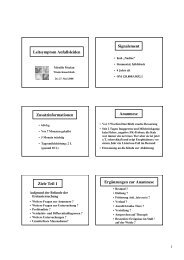Lifespan and Causes of Death in the Irish Wolfhound - Vetsuisse ...
Lifespan and Causes of Death in the Irish Wolfhound - Vetsuisse ...
Lifespan and Causes of Death in the Irish Wolfhound - Vetsuisse ...
Create successful ePaper yourself
Turn your PDF publications into a flip-book with our unique Google optimized e-Paper software.
3.8.1.3 Diagnosis<br />
The diagnosis <strong>of</strong> epilepsy is essentially a diagnosis through <strong>the</strong> exclusion <strong>of</strong> any<br />
o<strong>the</strong>r underly<strong>in</strong>g disease. The owner should be asked about illnesses or trauma,<br />
possibilities for <strong>in</strong>toxication, <strong>and</strong> vacc<strong>in</strong>ation history. A full neurological exam should<br />
also be performed, but should be repeated if generalised abnormities are detected<br />
soon after a seizure. Dogs with idiopathic epilepsy do not have <strong>in</strong>ter-ictal neurological<br />
deficits (Thomas 1994).<br />
Differential diagnoses <strong>in</strong>clude seizures secondary to Portosystemic shunt (see<br />
chapter 3.2), especially <strong>in</strong> younger animals; toxicity; structural bra<strong>in</strong> disease <strong>in</strong>clud<strong>in</strong>g<br />
tumours or scarr<strong>in</strong>g; <strong>and</strong> seizures second to o<strong>the</strong>r systemic disease processes. A full<br />
laboratory workup is <strong>in</strong>dicated to detect such possible changes. Fur<strong>the</strong>r possibilities<br />
<strong>in</strong>clude radiography, CT or MRI, <strong>and</strong> cerebrosp<strong>in</strong>al fluid analysis, depend<strong>in</strong>g on what<br />
o<strong>the</strong>r causes are suspected (Parent 2004).<br />
3.8.1.4 Therapy<br />
Treatment should be <strong>in</strong>itiated after <strong>the</strong> second generalised seizure, if <strong>the</strong>re are acute<br />
cluster seizures or status epilepticus. The latter two states should be addressed early<br />
<strong>and</strong> aggressively.<br />
Phenobarbital is <strong>the</strong> drug <strong>of</strong> first choice <strong>in</strong> <strong>the</strong> treatment <strong>of</strong> can<strong>in</strong>e epilepsy. The goal<br />
is to reach a serum level <strong>of</strong> 100-120 μg/ml <strong>in</strong> <strong>the</strong> steady state, which takes between<br />
12 <strong>and</strong> 15 days to reach.<br />
In dogs with hepatic <strong>in</strong>sufficiency or <strong>in</strong>sufficient reaction to Phenobarbital alone,<br />
potassium bromide (KBr) can also be used. Serum level <strong>in</strong> <strong>the</strong> steady state should be<br />
between 1.2-1.6 mg/ml<br />
3.8.1.5 Prognosis<br />
The life expectancy <strong>of</strong> <strong>Irish</strong> <strong>Wolfhound</strong>s affected with epilepsy is reduced by about<br />
two years (Casal, Munuve et al. 2006). This f<strong>in</strong>d<strong>in</strong>g should be <strong>in</strong>terpreted with<br />
caution, however, s<strong>in</strong>ce <strong>in</strong> <strong>the</strong> quoted study, <strong>the</strong> presented survival data <strong>of</strong> epileptic<br />
<strong>Wolfhound</strong>s are likely ta<strong>in</strong>ted with right censored data (see 3.1.1.3) <strong>and</strong> <strong>the</strong>n<br />
compared to <strong>the</strong> Bernardi data (see 3.1.3.1), which has been shown to also be<br />
subject to this bias <strong>in</strong> <strong>the</strong> present study.<br />
In a population <strong>of</strong> n=126 epileptic <strong>Irish</strong> <strong>Wolfhound</strong>s, 76 (60.3%) died as a direct result<br />
<strong>of</strong> <strong>the</strong> seizure disorder. These seizure-related deaths were classified as death dur<strong>in</strong>g<br />
seizure (16.1%), euthanasia due to uncontrolled seizures (65.8%), phenobarbital<br />
hepatotoxicity (6.6%), aspiration dur<strong>in</strong>g seizure <strong>and</strong> subsequent fatal pneumonia<br />
(6.6%), <strong>and</strong> euthanasia due to non-recovery after a seizure (3.9%). The o<strong>the</strong>r 50<br />
dogs (39.7%) died from unrelated causes. Median survival time after <strong>the</strong> first seizure<br />
did not vary significantly between different ages at onset (Casal, Munuve et al. 2006)<br />
as reproduced <strong>in</strong> figure 3.1 below. Aga<strong>in</strong>, <strong>the</strong>se survival data are right censored <strong>and</strong><br />
thus likely too low.<br />
38


